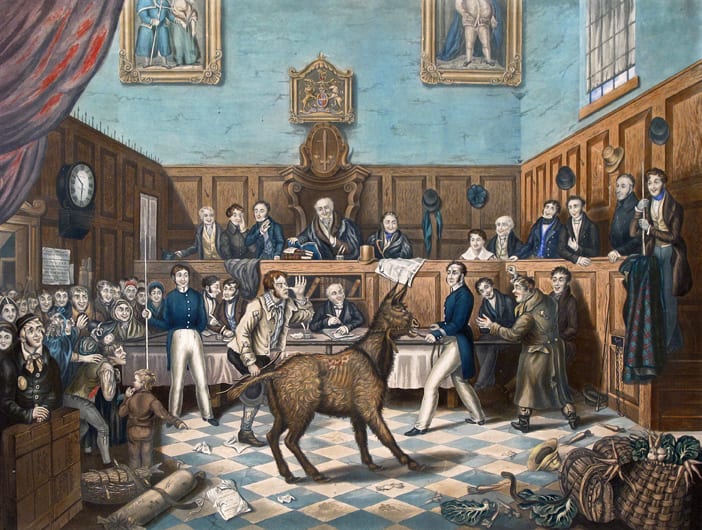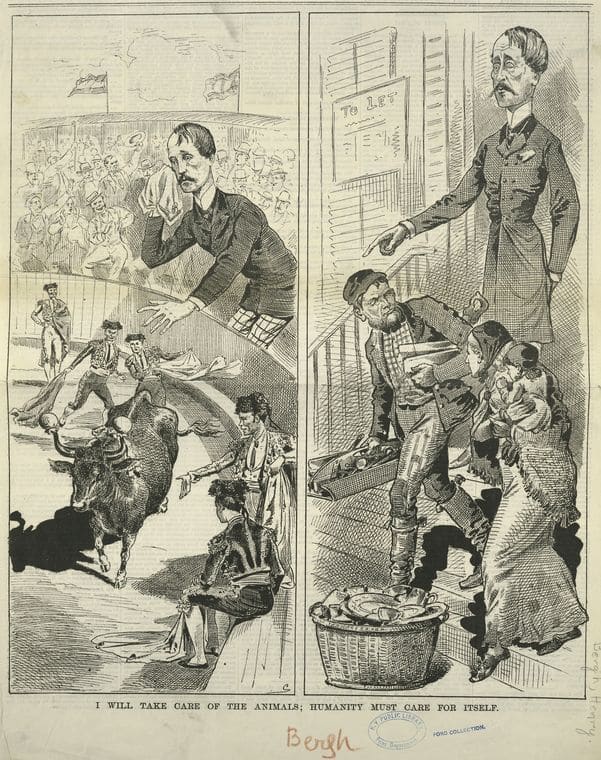| This is a Draft Amnesty Week draft. It may not be polished, up to my usual standards, fully thought through, or fully fact-checked. |
This post is adapted from notes I made in 2015 while trying to figure out how EA compared to other movements.
- Society went from treating animals as objects to sometimes treating them as beings / moral patients, at least dogs and horses.
- A few lone voices (including Bentham) in the 1700s, then more interest in the 1800s. First bill introduced 1809, first bills passed in 1820s (Britain and Maine).
- Richard Martin "Humanity Dick" — Irish politician who got some success on the 1822 "Ill Treatment of Cattle Bill" after a series of failed anti-cruelty bills. His work was interrupted when he fled to France after losing his seat in Parliament, which meant he was no longer immune to being arrested for his gambling debts.
- First success with enforcement came from a publicity stunt (in a case about abuse of donkey, bringing the donkey into court) which caused coverage in media and popular song

- Animal welfare work was initially thought of as largely for the benefit of human morality (it's bad for your soul to beat your horse) or to prevent disgust caused by witnessing suffering, not necessarily for the animals themselves.
- British movement had several false starts; failed legislation and “societies” which died out. Society for the Prevention of Cruelty to Animals took off in 1824 led by a minister and four members of parliament (including William Wilberforce, main leader of British abolition movement), but lost steam after an initial burst of fundraising. Office was closed and they met in coffee houses. Main staff member was jailed for the society’s debts, another staff member continued working as a volunteer. Fortune turned when Princess Victoria (later Queen) and her mother decided they liked the organization, became the Royal Society for the Prevention of Cruelty to Animals. RSPCA. 1837 essay competition with equivalent of $1500 prize led to four essays being published as books.
- One man (Henry Bergh) imported the movement to NYC in the 1860s after hearing about it in London during his work as a diplomat. Pushed first animal abuse legislation through NY legislature and was its single-handed enforcer; got power to arrest and prosecute people despite not being an attorney. Founded the ASPCA (American Society for the Prevention of Cruelty to Animals), initially self-funded. Early on, a supporter died and left the society the equivalent of $2.8 million. Bergh did a lecture tour of the western US resulting in several offshoot societies.
Got enough print coverage of his work that legislation spread to other states. Summary of his character based on interviews: “He was a cool, calm man. He did not love horses; he disliked dogs. Affection, then, was not the moving cause. He was a healthy, clean-living man, whose perfect self-control showed steady nerves that did not shrink sickeningly from sights of physical pain; therefore he was not moved by self-pity or hysterical sympathy….No warm, loving, tender, nervous nature could have borne to face it for an hour, and he faced and fought it for a lifetime. His coldness was his armor, and its protection was sorely needed.” - Widespread mockery of main figures as sentimental busybodies. Bergh was mocked as “the great meddler.” Cartoon depicting him as overly caring about animals while there are people suffering — feels very parallel to some criticisms of EA.
- Welfare movements for children and animals were entwined both in Britain and US (American Humane was for both children and animals almost from the beginning). Early norm that both children and animals more or less belonged to their owners and could be treated however that owner saw fit; not a matter for the courts. Early child protection case in NYC: someone trying to prosecute the abusive foster parents of a child went through Henry Bergh of the ASPCA, who won the case and got the New York Times to cover it. He then co-founded the New York Society for the Prevention of Cruelty to Children.
More stuff you might enjoy on history of movements:
- Animal Charity Evaluators' project on social movements, including children's rights as a parallel to animal advocacy
- I haven't read it, but the Oxford Handbook of Social Movements is probably a treasure trove


Nice write up! Henry Bergh was awesome. I highly recommend a biography on him called "A Traitor to His Species".
It's a treasure trove of fascinating anecdotes about early animal rights advocacy. It's been a minute since I read it, but these parts stuck with me:
We have a copy, if anyone in the Boston area would like to borrow it. I tried to read it but found it very slow going.
This was a delight to read! I found the fact that an essay competition in 1837 was a successful activist move really striking!
Executive summary: The animal welfare movement emerged in the 18th-19th centuries, overcoming initial challenges to establish animal cruelty as a legal and moral issue, and was closely linked with the early children's rights movement.
Key points:
This comment was auto-generated by the EA Forum Team. Feel free to point out issues with this summary by replying to the comment, and contact us if you have feedback.